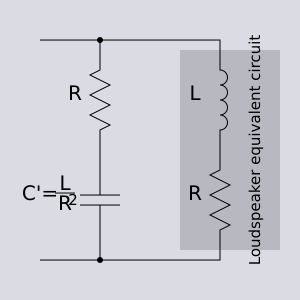Boucherot cell
- This article relates to loudspeaker driving. See Zobel network for a more general description of telecommunications usage.
A Boucherot cell (or Zobel network) is an electronic filter, used in audio amplifiers to damp high-frequency oscillations that might occur in the absence of loads at high frequencies. Named after Paul Boucherot a Boucherot cell typically consists of a resistor and capacitor in series, usually placed across a load for stability.[1]
It is commonly seen in analog power amplifiers at the output of the driver stage, just before the output inductor. The speaker coil inductance of a loudspeaker generates a rising impedance, which is worsened by the output inductor generally found in analog power amplifiers; the cell is used to limit this impedance.[2]
The documentation for some power operation amplifiers suggests the use of a "Boucherot cell between outputs and ground or across the load".[3]
Additionally, Boucherot cells are sometimes used across the bass driver (and mid-range) of a speaker system, in order to maintain a more constant driving point impedance as "seen" by a passive crossover. In this specific arrangement, the Boucherot cell is part of a Zobel network.[2]
Some loudspeaker crossover designs aim to stabilize impedance at high frequencies by including Zobel networks.[4]
See also
- RC snubber
References
- ↑ "Boucherot cell" in AES Professional Audio Reference.
- ↑ 2.0 2.1 "Zobel network or Zobel filter" in AES Professional Audio Reference.
- ↑ ST, LOW DROP DUAL POWER OPERATION AMPLIFIERS, July 2003, Top of Page 5, right column.
- ↑ Bell Labs Journal: Zobel, O. J., "Theory and Design of Uniform and Composite Electric Wave Filters", Bell Sys. Tech. J., Vol. 2, pp. 1–46, Jan 1923.
de:Boucherot-Glied
 |


